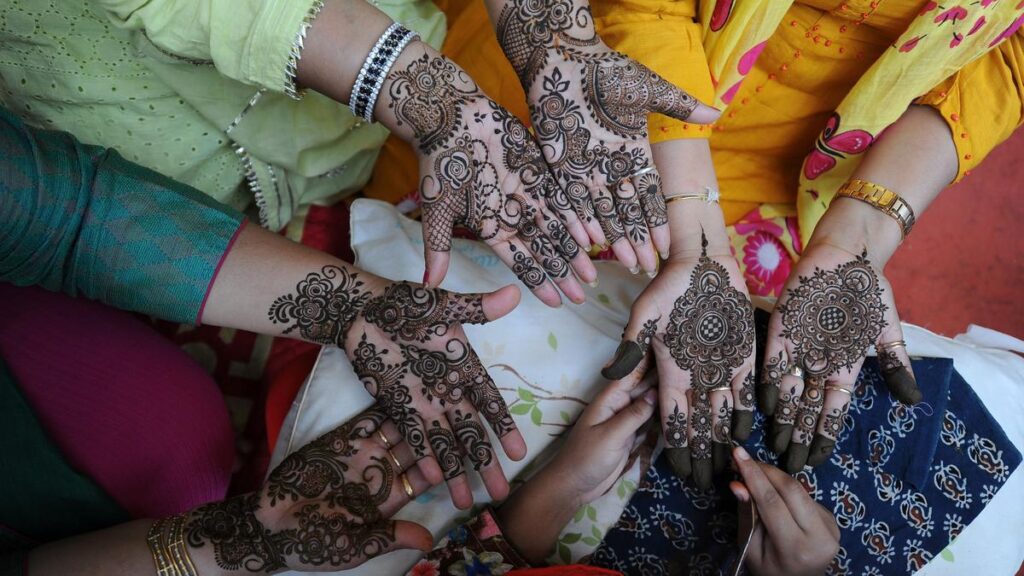For centuries, mehendi has been an essential part of Indian celebrations, symbolising joy and auspicious beginnings at weddings and festivals. Traditionally made from the crushed leaves of the Lawsonia inermis plant, natural mehendi or henna, has been valued for its cooling properties and the gentle, reddish-brown stain it imparts. However, a growing body of reports about burns, allergic reactions, and even long-term skin damage after mehendi application has raised an important question: is all mehendi truly safe today?
The problem with modern mehendi
To meet the rising demand for faster, darker stains, many commercially available mehendi products are now mixed with additives and chemicals. One such chemical is as para-phenylenediamine (PPD), a synthetic compound used to intensify and quicken colour development, producing a near-black stain within hours.
“Natural henna is generally safe and gives a brown to red color. But most commercially available mehendi is adulterated with PPD,” explains D. Dinesh Kumar, president of the Tamil Nadu branch of the Indian Association of Dermatologists, Venereologists and Leprologists (IADVL) and chief dermatologist at Dr. Dinesh Skin & Hair Clinic, Chennai. “PPD can cause severe allergic reactions, leading to burns, blisters, and long-term skin sensitisation. While permitted in controlled concentrations for use in hair dyes under international regulations, it is not approved for direct application on the skin. When mixed into mehendi, often without disclosure, it turns a traditionally safe cosmetic into a potential hazard.”
Allergic reactions and burns
When adulterated mehendi containing PPD is applied to the skin, the chemical can rapidly penetrate the outer barrier and provoke a delayed hypersensitivity reaction — marked by a severe immune response. In susceptible individuals, this manifests as intense itching and burning within hours of application, swelling, redness, and inflammation along the design, formation of fluid-filled blisters or ulcers. In severe cases, permanent scarring and pigment changes can occur.
The risk is higher in people with pre-existing skin conditions like eczema, or those with repeated exposure to cosmetic allergens.
“Even someone who has used mehendi safely for years can suddenly develop an allergy if exposed to adulterated products,” says Dr. Dinesh.
This phenomenon, known as sensitisation, means the immune system becomes primed to overreact to the chemical after initial exposure. Once sensitised to PPD, individuals are at lifelong risk of reacting not only to henna but also to related chemicals in hair dyes, black clothing dyes, and even certain types of rubber or adhesives.
How to recognise unsafe mehendi
Spotting chemical-laced mehendi can be difficult, but there are signs consumers can look out for in products that promise instant dark color. Natural henna stains take 24–48 hours to fully darken from orange to deep brown. Black or very dark stains appearing within 1–2 hours are suspicious. A chemical odour can be a tell-tale sign, as pure henna has an earthy, grassy aroma. A strong chemical or ammonia-like smell indicates chemical contamination. Also, read label warnings: exercise caution if the cone or packet promotes “instant color,” “dark black color,” or lacks a full ingredient list. Choosing organic-certified henna powders or cones from reputable brands can reduce risk, but even then, vigilance is key.
Performing a patch test is a simple but crucial step to prevent adverse reactions. Dr. Dinesh recommends: “Apply a small amount of henna on the inner arm or behind the ear. Monitor for any redness, itching, or discomfort over 48 hours. If there is no reaction, it is generally safe to proceed.”
Those with known allergies, sensitive skin, or a history of eczema should be especially cautious and preferably consult a dermatologist before application.
What to do if a reaction occurs
If symptoms like burning, redness, or blistering develop after applying mehendi, remove the paste immediately using lukewarm water and mild soap. Avoid scrubbing the affected area aggressively and instead, gently cleanse it. Apply a cool compress to help soothe any inflammation. Refrain from using over-the-counter ointments without medical advice. It is important to consult a dermatologist promptly, especially if blisters, peeling, or a widespread rash occurs. Early medical intervention by seeking out a qualified dermatologist can prevent complications like secondary bacterial infections and reduce the risk of lasting pigmentation changes.
Repeated exposure to PPD-containing mehendi does not just cause short-term discomfort. “Lifelong sensitisation to PPD is likely after an acute reaction,” warns Dr. Dinesh. Over time, this can lead to itchy and flaky skin due to chronic eczema, permanent pigmentation changes (hypo- or hyperpigmentation) and cross-reactivity with other chemicals, complicating future cosmetic or dermatological treatments
In severe cases, individuals may find themselves unable to use not just hair dyes, but everyday products like colored textiles or adhesives, significantly impacting their quality of life.
Being aware is key
The cultural significance of mehendi is undeniable, but safeguarding health must take precedence over aesthetic appeal. Some steps in this direction include opting for natural henna powders prepared freshly with lemon juice or tea water at home, buying only from trusted sources that disclose full ingredients, avoiding any product labeled “black henna” or “instant color” and making sure we educate those we know about the risks associated with adulterated mehendi, especially in community settings like weddings or fairs. Given that some cosmetic products may contain potentially harmful additives, making informed choices and maintaining strong regulatory oversight are important for consumer safety.
The beauty of mehendi lies not just in its intricate patterns, but also in the centuries-old tradition of natural, mindful artistry. By returning to its authentic roots, we can ensure that mehendi continues to be a safe and joyous part of our celebrations
(Dr. Monisha Madhumita is Assistant Professor, Department of Dermatology, Venereology and Leprosy, Saveetha Medical College, Chennai. [email protected])
Published – May 02, 2025 06:00 am IST

